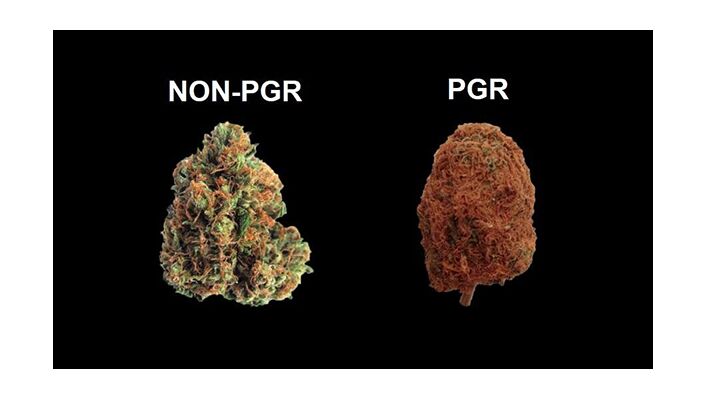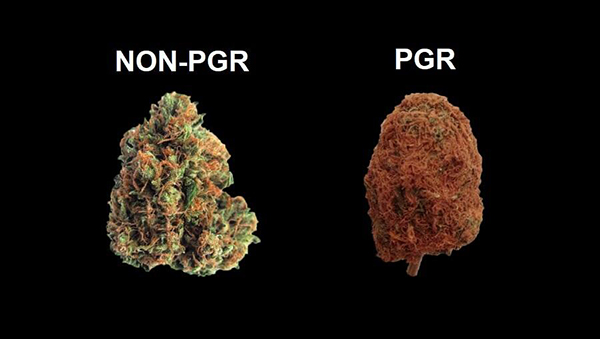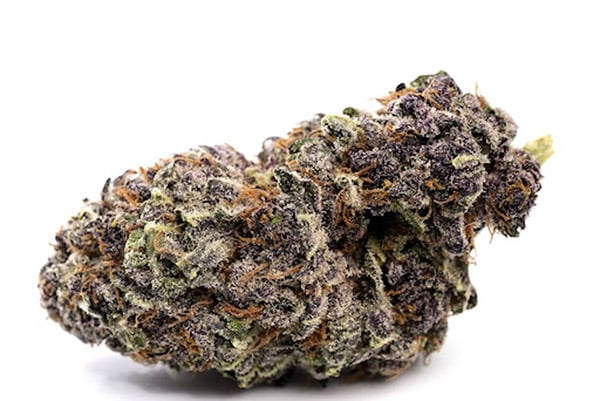What is PGR weed, and how to spot it?

What is PGR weed, and how to spot it?

As the debate over genetically modified foods rages on, there is now concern about genetically modified cannabis.
While genetically modified cannabis is not on the market, plant growth regulators (PGR) are being used to alter cannabis chemically.
PGRs are being used to control different aspects of plants' growth. These chemicals can be used to increase the size of different parts of the plant.
For example, growers do this to increase fruit size, control flowering time, and better control the size of certain parts, such as roots or stems. The problem is that these plant growth regulators are often toxic chemicals that should not be eaten, let alone smoked. The concern is that unscrupulous growers are using these chemicals to increase profits at the expense of people's health.
PGR weed doesn't even have standard amounts of cannabinoids, terpenes, and trichomes. In some cases, it may not even develop any THC.
The cannabinoids like CBD and THC are the main appeal for recreational and medical marijuana. Customers could easily get shortchanged or worse, end up smoking something that only poses health risks.
What is PGR weed?

PGR weed is cannabis grown with plant growth regulators. These chemicals are often synthetic and alter plant growth to increase yields or achieve desired effects. In cannabis growth, they are used to make larger, denser flowers.
Ordinarily, larger crop yields and denser flowers would be a good thing. However, the chemicals used to achieve this alter the plant and disrupt THC development. They are used to increase the size and weight of cannabis while virtually eliminating beneficial cannabinoids, terpenes, and trichomes from the plant.
Not only are unsuspecting customers spending money on marijuana that may not have any of the desired effects, but they are also putting their health at risk by burning and ingesting chemicals that are not fit for human consumption.
In addition, many of these PGRs have been banned for use in food-based crops and are legal only for ornamental plants.
So why are some growers using them? Despite the legalization of cannabis in many states, there are still many black market growers. Indeed legalization has increased the demand for weed.
Some black market growers are cashing in on this by using PGR to exaggerate the cannabis they grow and sell illegally.
While legal marijuana follows laws, regulations, and tests, there is still plenty of illegal street weed that may have been grown with PGRs.
What are plant growth regulators?
Plant growth regulators are synthetic or organic chemicals that regulate specific parts of plant growth and development. This includes dormancy, fruit growth, and the length and size of stems and roots. These plant genetic resources are popular because the plants they produce look more desirable.
Growers also use PGR to increase the plants' health and resistance to cannabis mold.
Plant growth regulators are not inherently bad. The problem is that the regulators used to increase yields in cannabis could well be making the product dangerous for consumers.
Organic plant growth regulators and synthetic plant growth regulators
There are organic/natural plant genetic resources used in agriculture and food production.
Kelp, for example, contains natural plant hormones that can help increase yields. Other natural plant growth regulators include chitosan, a sugar found in the exoskeleton of shellfish, and trials derived from alfalfa hay.
These natural plant growth regulators have effects similar to those of synthetic versions. They can increase and enhance growth patterns. And being natural, they present no risks to human health and are environmentally friendly, so they don't damage waterways in runoff or damage local biodiversity.
Organic PGRs are less effective than synthetic PGRs. They are also more expensive, so black market growers are naturally attracted to synthetic options.
They can produce the big, fat, dense, and richly colored money-making buds that increase profits. But synthetic plant hormones produce tasteless and nearly useless buds because they don't deliver the cannabinoids that those seeking recreational or medicinal marijuana are after.
How to spot PGR weed?
While shady characters try to use plant growth regulators to increase profits, there are several ways to identify PGR weeds.
The key ways to identify PGR weed from standard cannabis are:
Excessive red or brown hair
Cannabis plants usually have hairlike pistils. PGR weeds will have more hairlike fibers that are brown and red in color. They tend to grow more of these hairs rather than trichomes or crystals containing the desired THC.
No crystals
Speaking of no trichomes, if you see very few crystals, it's probably because PGR disrupts the development of terpenes, trichomes, and cannabinoids.
No smell
PRG can disrupt the development of terpenes. This means that PGR cannabis will often lose that distinct weed smell.
Various terpenes and cannabinoids have unique odors that form a rich bouquet when you smell the buds. If you tear off a piece and don't smell anything, it could well be PGR weed.
Dense, heavy, and rock-solid buds
PGR forces a lot of growth in the flowers. This will lead to denser and heavier nuggets. Unfortunately, this can also lead to a hard texture that feels weird to the touch.
The spongy, moist texture
If cannabis has a strange moist or spongy texture, this could also be a sign of PGR use.
Chemical smell or taste
If you get a pungent chemical taste or smell from the weed or smoke, this is a clear sign of PGR weeds.
This can even lead to a very brief chemical reaction that leaves you tired later.
Summing up
You can identify PGR cannabis by its lack of aromatic flavonoids and terpenes, its lack of the rich flavor (or enhanced, harsh chemical odor/taste) characteristic of weeds, and its "polished," hard, and often brightly colored appearance.
So when it comes to PGR weed versus natural cannabis, if your bud looks a little dead and unattractive, but it smells and feels good, then it's better to choose the less dramatic-looking variant than the cosmetic variant, as the latter could eat into your budget and make you sick at the same time.
What are the most common synthetic hormones used to produce PGR weed?
The three most common synthetic PGRs used in cannabis cultivation are chlormequat chloride, daminozide (aka Alar), and Paclobutrazol.
All three increase growth and ensure that flowers become the largest and densest part of the plant.
The problem is that all three have detrimental effects on the human body.
Chlormequat Chloride
Chlormequat Chloride promotes larger bud growth by slowing the growth of other plant areas. Although not as carcinogenic as the other synthetic plant growth regulators, it may cause skin and eye irritation and even organ damage.
Daminozide
Daminozide, also known as Alar, slows leaf and stem growth and increases bud size. But that's not all; It also limits the development of terpenes and cannabinoids. That means no THC or CBD.
The Environmental Protection Agency (EPA) has classified daminozide as a probable carcinogen and banned its use in food. It was previously used as a spray on fruits, vegetables, and other food crops. It shouldn't be smoked if it's not fit for human consumption!
Paclobutrazol
Paclobutrazol limits plant cell elongation, which also increases flower and bud density. However, paclobutrazol also limits cannabis's ability to produce THC. Of the three, it is also the most toxic.
If you inhale PGR weeds grown on paclobutrazol, it breaks down into nitrosamines. The same highly carcinogenic chemical is found in cigarettes.
How do growers apply synthetic hormones?
Making PGR weeds is not difficult. While responsible growers consider the needs of the plant, the most irresponsible growers use the following methods:
Spraying pants
Watering -- the PGRs are mixed into the water that is used when irrigating the plant's soil. So the roots absorb the substances.
Stretching -- is a hybrid of a spray and a drench application.
The PGRs are applied to the leaves and flowers through a high-volume spray.
What are the health risks of using PGR weed?
Some of the first symptoms of using PGR weed are low energy, low power, lethargy, and severe headaches.
In the long term, these toxins can cause liver and kidney damage, neurotoxicity (where the normal activity of your nervous system is severely altered), fertility problems, various cancer risks, skin and eye damage, and more.
How common is PGR weed in the United States, and is it legal?
Unfortunately, PGR weed has become quite common in the United States across the illegal cannabis market.
PGRs are banned for use on plants that are for human consumption and agricultural environments for food crops. However, PGRs are still available for decorative plants.
How do people know that cannabis products contain PGR weeds?
If you plan to smoke weed, you can identify PGR cannabis by its appearance, texture, and smell (or lack thereof).
However, if you use vape carts or edibles made from PGR cannabis, you will most likely find that the product has a chemical taste and a specific chemical odor.
Some users begin to feel dizzy or nauseous after consuming the product.
Conclusion
Due to the adverse health implications of consuming PGR cannabis, you should buy and consume legally grown cannabis that has been obtained from authorized growers and certified dispensaries.
While buying cannabis from dispensaries and authorized growers may cost more money, the extra cost will bring peace of mind and will help you avoid PGR cannabis.





